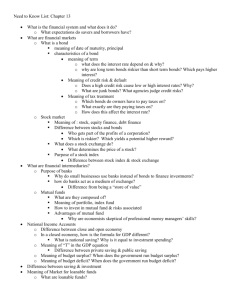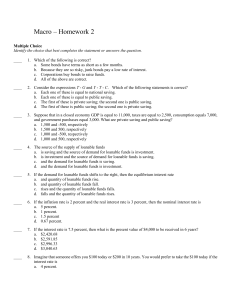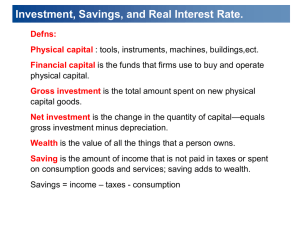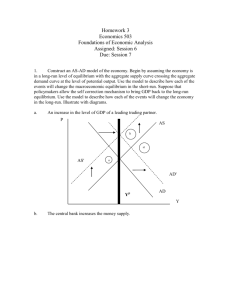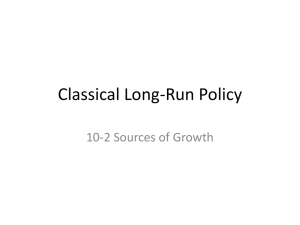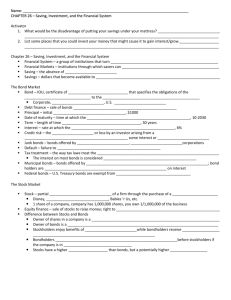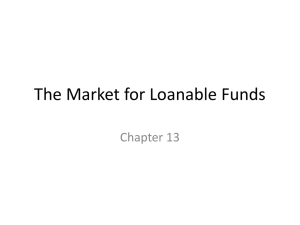LOANABLE FUNDS, SAVING & INVESTMENT, AND FINANCIAL
advertisement
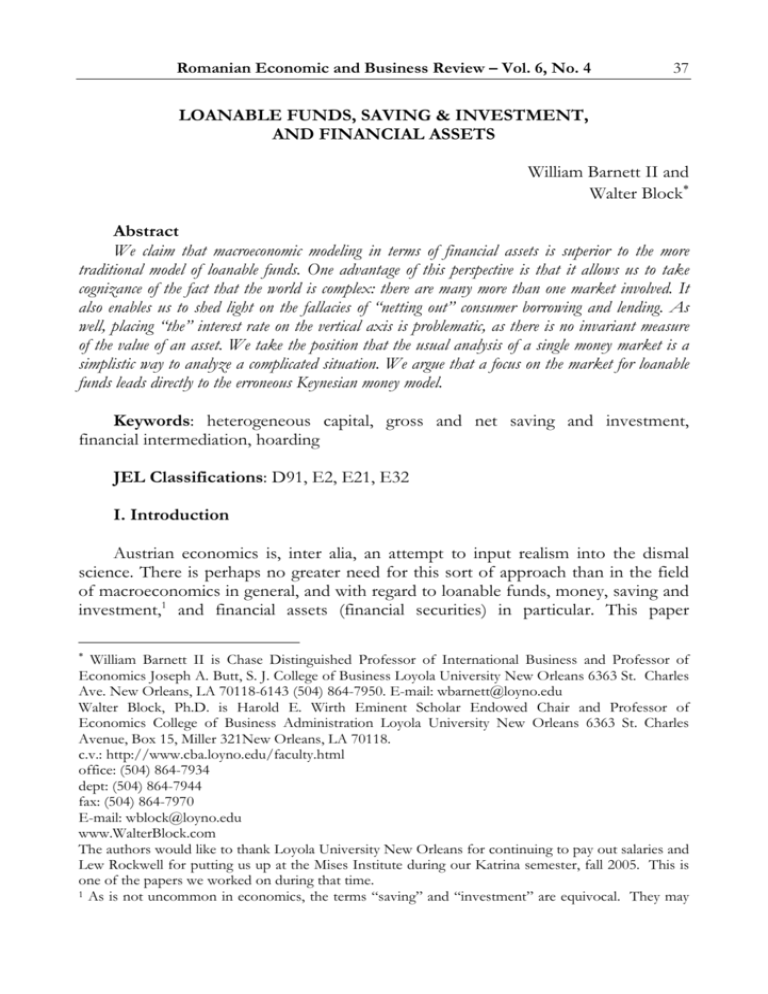
Romanian Economic and Business Review – Vol. 6, No. 4 37 LOANABLE FUNDS, SAVING & INVESTMENT, AND FINANCIAL ASSETS William Barnett II and Walter Block Abstract We claim that macroeconomic modeling in terms of financial assets is superior to the more traditional model of loanable funds. One advantage of this perspective is that it allows us to take cognizance of the fact that the world is complex: there are many more than one market involved. It also enables us to shed light on the fallacies of “netting out” consumer borrowing and lending. As well, placing “the” interest rate on the vertical axis is problematic, as there is no invariant measure of the value of an asset. We take the position that the usual analysis of a single money market is a simplistic way to analyze a complicated situation. We argue that a focus on the market for loanable funds leads directly to the erroneous Keynesian money model. Keywords: heterogeneous capital, gross and net saving and investment, financial intermediation, hoarding JEL Classifications: D91, E2, E21, E32 I. Introduction Austrian economics is, inter alia, an attempt to input realism into the dismal science. There is perhaps no greater need for this sort of approach than in the field of macroeconomics in general, and with regard to loanable funds, money, saving and investment,1 and financial assets (financial securities) in particular. This paper William Barnett II is Chase Distinguished Professor of International Business and Professor of Economics Joseph A. Butt, S. J. College of Business Loyola University New Orleans 6363 St. Charles Ave. New Orleans, LA 70118-6143 (504) 864-7950. E-mail: wbarnett@loyno.edu Walter Block, Ph.D. is Harold E. Wirth Eminent Scholar Endowed Chair and Professor of Economics College of Business Administration Loyola University New Orleans 6363 St. Charles Avenue, Box 15, Miller 321New Orleans, LA 70118. c.v.: http://www.cba.loyno.edu/faculty.html office: (504) 864-7934 dept: (504) 864-7944 fax: (504) 864-7970 E-mail: wblock@loyno.edu www.WalterBlock.com The authors would like to thank Loyola University New Orleans for continuing to pay out salaries and Lew Rockwell for putting us up at the Mises Institute during our Katrina semester, fall 2005. This is one of the papers we worked on during that time. 1 As is not uncommon in economics, the terms “saving” and “investment” are equivocal. They may 38 Loanable Funds, Saving & Investment, and Financial Assets attempts to apply a modicum of realism to these fields, while making the case that the mainstream neoclassical tradition is wanting in these arenas of study. In section II we discuss loanable funds in contrast to saving and investment and in section III discuss financial assets versus saving/investment and loanable funds. The focus of section IV is to demonstrate that reasoning on the basis of “the” market for loanable funds is inappropriate. Section V concerns “netting out” consumer borrowing and lending and section VI deals with financial securities. We conclude in section VII. There are also three appendices: the first elaborates on geometrical considerations, the second presents a summary of our argument in table format and the third offers an algebraic treatment. II. Loanable Funds v. Saving & Investment According to Austrian business cycle theory (ABCT), market interest rates greater (less) than the relevant “natural” rates cause an excess (shortfall) of planned financial saving relative to planned financial investment.2 “Natural” rates, in turn, are those that would arise in a free market3 based upon underlying time preferences, perceptions of risks of all types, and expected productivities, and other factors.4 These natural rates would prevail in the absence of monetary inflation in the form of injections of new money into credit markets; i.e., they are the rates that would exist if new money was not lent into existence by government or through fractional reserve banking. We have all seen the figure (e.g., Garrison, 2001, p. 37) with “the” interest rate measured along the vertical axis and the quantities of saving and investment or, alternatively, the quantity of loanable funds, measured in monetary terms along the horizontal axis.5 Featured in such diagrams are a downward-sloping investment curve refer to “financial” or “real” saving or investment. Financial investment is refers to the purchase of financial assets; e.g., stocks, bonds, and bank deposits, whereas real investment refers to the production of capital goods, and, in its most broad sense, consumer’s durables and human capital, as well. For more on this latter point, see Barnett and Block, (2007A). 2 Although it is, of course, possible, for the plans of financial savers and such investors to differ, they are identical ex post, being brought into equality, ceteris paribus, by fluctuations in interest rates, whereas real saving and investment are identical, and therefore cannot differ (Barnett and Block, 2007A). Real saving/investment is brought into accord with people’s preferences via changes in relative prices. 3 In a free market there would be absolutely no governmental interventionism in any form regarding credit markets and institutions. 4 On this, Barnett and Block (2006). 5 In some cases, the figures are consistent: the horizontal axis is labeled “loanable funds” (saving and investment) and the curves are labeled supply of, and demand for, loanable funds (saving and investment); however, in others, they are inconsistent: the horizontal axis is labeled “loanable funds” and the curves are labeled saving and investment, implying necessary one-to-one relationships between saving and the supply of loanable funds, on the one hand, and between investment and the demand for loanable funds, on the other. For examples of a consistent and an inconsistent case see, respectively: Garrison (2001, 37); Garrison (1996, 113). Because of this, hereinafter when referring to this type of analysis, the terms “saving/supply-of-loanable-funds” and “investment/demand-for- Romanian Economic and Business Review – Vol. 6, No. 4 39 and an upward-sloping saving curve or, alternatively, downward-sloping demand for, and upward-sloping supply of, loanable-funds curves. The market thus depicted is referred to as the “loanable funds”6 market. It is used to illustrate the difference between a decrease in the social time preference, and an artificial increase in the supply of credit that arises in the act of government or fractional reserve banks creating “deposit money.”7 Either causes an outward shift in the savings/supply-ofloanable-funds curve. (Figures 1A, 1B, 2A, 2B, 3A, and 3B in appendix 1 show these various ways of depicting the “loanable funds” market.) At the initial market clearing rate of interest the “saving/loanable-funds (now) exceeds investment/demand-forloanable-funds;” i.e., there is a “surplus of saving” or, alternatively, “a surplus of loanable funds,” which surplus causes the interest rate to fall until a new market clearing rate8 is established at the intersection of the new saving/supply-of-loanablefunds curves and the old investment/demand-for-loanable-funds curve.9 Although this may be a useful pedagogic device, it is not without its faults. Let us consider several difficulties with the analysis so far. 1. As real investment/saving is a form of production,10 and what is produced are heterogeneous capital goods,11 the only way they can be meaningfully aggregated for measurement is to use the common denominator of monetary value. However, as we know, Cambridge, England’s Neo-Marxists-Neo-Ricardians-Post-Keynesians decisively defeated Cambridge, Massachusetts’ neoclassicals precisely on this point, by elucidating the fact that the price of an asset is based on the present value of the net cash flows expected to be generated therefrom in the future, which value will fluctuate with “the” discount rate, and, therefore, there is no invariant measure of the value of an asset (Harcourt, 1972, 46; Cohen and Harcourt, 2003). How then do we measure the value of saving and investment on the horizontal axis? Most authors loanable-funds” are used. 6 Garrison (2001, 37), also refers to it as the market for “investable resources.” 7 Were new money spent, rather than lent, into existence the effect in the loanable-funds market would be indirect and undoubtedly of considerably less magnitude. 8 This is an oversimplification. One of the factors held constant along the invest/demand-forloanable-funds curve is the creditworthiness of the borrowers. If at the relevant interest rates lenders are willing to accept greater risk of default then the investment/demand-for-loanable-funds curve shifts outward; i.e., the demand increases. In that case actual interest rates will decline by less than they otherwise would. In fact, depending upon the extent to which lenders reduce their standards, actual interest rates might not fall at all, or might even increase. Of course, in any of these cases the (default) risk adjusted interest rates necessarily decrease. 9 In the former case, the new lower rate is warranted by the decreased time preference and the result is faster capital accumulation and growth. In the latter case, the new lower rate is not justified on the basis of consumer preferences for present and future spending; it is artificially low, below that consistent with an unchanged time preference, and initiates the artificial boom in the form, of an unsustainable misallocation of resources, and consequent crisis and bust. On this see, e.g. Garrison, 1996, pp. 111-123, especially p. 112. 10 For a defense of this claim see Barnett and Block (2007A). 11 For purposes of this paper we exclude durable consumers’ goods and human capital. 40 Loanable Funds, Saving & Investment, and Financial Assets who draw such diagrams take the position that the relevant market is that for loanable funds. They aver that the supply is provided by those (lenders/households) whose income exceeds their desired expenditures on consumers’ goods at various rates of interest and the demand is by provided by those (borrowers/businesses) whose (net) income falls short of their desired expenditures on new capital goods at various interest rates.12 In this case if we measure the quantity of loanable funds offered and bid for, in the loanable-funds market in monetary terms, we have the problem of an inconstant measure, because of inflation or deflation. 2. The implication of the model depicted above is that interest rates are the price of saving and investment and they fluctuate to clear the “saving-investment market,” i.e., to coordinate the actions of savers and investors. Although this analysis is deeply embedded in the economics profession, it is incorrect.13 To the extent that fluctuations in interest rates (rather than in the prices of financial assets – to be sure there is a one-to-one relationship between the two for any given financial asset) clear markets, they are credit markets, not some non-existent markets for saving and investment. This can be seen with the aid of a thought experiment. Imagine an economy in which the only goods produced were consumer services and consumables.14 That is, one in which there is no saving and investment. Even in such an economy there could be credit – A lends B two apples today for three apples one year from today; therefore, there can be interest and interest rates even absent money, saving, and investment. This, of course, is because, even in a no saving and no investment environment, there can and will be (positive) time preference. Note that although there can be interest and interest rates in a barter economy, the only situation in which they are calculable is that in which what is promised in return for the loan is a quantity of the same good: two apples today for three apples one year from today yields interest of one apple on a principal of two apples for an interest rate of 50% per annum. What however is the quantum of interest and, a fortiori, the interest rate for: three apples today for four (or, perhaps, two) oranges one year from today? It is impossible to answer this question intelligibly. 3. An additional problem pertains to the concept of gross in contradistinction to net. That is, the use of saving and investment; i.e., the identification of saving and investment, with loanable funds, facilitates the avoidance of analytical problems Of course, to the extent that the borrowers spend the funds on consumers’ services and nondurables this is not “investment,” under any criterion. Even if this is referred to as “saving” by the lender, it is used for the purpose of “dissaving,” not investment, by the borrower. 13 It is true that Keynesian analysis maintains that under certain conditions interest rates can not decrease sufficiently to equalize saving and investment, thereby necessitating decreases in income to complete the task, but this is irrelevant for the point at hand. The relevant flaw in Keynesian analysis is the idea that “the” interest rate is determined in “the” market for money; i.e., “the” interest rate is “the” price of money. But this is a flawed concept. (Barnett and Block, 2009) 14 This is obviously a barter economy because there are no capital goods and money is a capital good. For more on this see Barnett and Block (2005). 12 Romanian Economic and Business Review – Vol. 6, No. 4 41 arising out of financial intermediation. The use of financial assets forces us to face these problems, squarely. We are forced to consider a multiplicity of markets for financial assets, realizing that the suppliers in some are demanders in others, and that it is precisely those funds they receive as suppliers of financial assets in some markets that allows them to be demanders of different financial assets in the others; e.g., banks sell certificates of deposits and then use the funds, at least in part, to buy notes. Perhaps more relevant in the current economic environment are “asset backed securities,” forms of derivatives in which the “assets” are themselves financial securities; e.g., credit-card receivables and those Collateralized Mortgage Obligations (CMOs) the Ms of which are sub-prime “mortgages.”15 Some economic actors (those in surplus) do not wish to exercise direct control over the entirety of their wealth. There are others (those in deficit) who wish to exercise command over more than the entirety of their wealth. We must analyze the role that the prices of assets, real as well as financial, play in bringing into harmony the plans of these diverse economic actors. Moreover, because some people exercise direct control over at least a part of their wealth for the purpose of investment, the role played by asset prices in affecting these decisions must also be considered. That, is we must examine, in light of the current structure of consumption and production, the effects of the preferences of individuals in their roles as consumers, for current and future consumption. Within those categories, we must study different individuals’ consumers’ goods or assets, and their preferences, in their roles as producers, for capital goods and human capital, and how these are manifested in the markets for assets, including importantly the markets for financial assets. For as these preferences affect asset prices they necessarily influence the allocation of resources. And, of course, these asset prices can be affected not only by changes in preferences, but also by injections of fiat credit. III. Financial Assets v. Saving/Investment and Loanable Funds Real saving and investment are identical both ex ante and ex post. We speculate that the reason the same objective phenomenon – production of capital goods, human capital, or consumers’ durables – has two (2) entirely different and completely unrelated names is because we look at the phenomenon of preparing for future consumption through two very different lenses, those of: 1) he who tries to prepare for the future not by producing for himself durable consumers’ goods he wants now or expects to want in the future (the specific nature of which, presently, he is not even sure) or capital goods or human capital, but by, in his own eyes, refraining from current consumption and making the resources so freed available to 2), he who tries 15 The term “mortgage” is commonly misused to mean a note; i.e., a written document that is evidence of a debt. In fact a mortgage is a security device whereby a debtor pledges a piece of property as security for the debt evidenced by the note. 42 Loanable Funds, Saving & Investment, and Financial Assets to provide, directly or indirectly, for the satisfaction of future consumption wants16 by actual production of consumers’ durables now or of consumers’ goods of any type in the future by acquiring control of resources and directing them to the current production of consumers’ durables, human capital and capital goods. Both real saving and real investment are acts of production of capital goods, human capital, and/or consumers’ durable goods. Failure to recognize this fact leads to confusion regarding “the” loanable-funds market. Garrison (2001, 36-40) analyzes the market for loanable funds, or as he also refers to it, “investable resources.”17 The figure he uses to illustrate his discussion (Garrison, 2001, 37, fig. 3.1) displays saving and investment on the horizontal axis,18 the interest rate on the vertical axis, and an upward sloping saving, and a downward sloping investment curve. He is able to do this because his analysis allows him to equate saving and investment with the supply of, and demand for, loanable funds, respectively.19 Garrison (2001, 36) includes “saving in the form of the purchasing of equity shares” in the supply of loanable funds; i.e., funds spent in purchasing equities are included in the supply of loanable funds. This is quite correct and adds to our understanding of the issues. Garrison (2001) can and should be read to include under this rubric, and correctly so, businesses’ supplies of loanable funds. However, when he states that they are “saving [sic] by all income earners made available to the business community to finance investment, to facilitate capital accumulation, to maintain and expand the economy’s capital structure” [emphasis added], this is implicit, whereas for the sake of clarity it should be made explicit. This author (2001, 36) also includes retained earnings in the supply of, and in the demand for, loanable funds on the grounds that “[r]etained earnings can be understood as funds that a His own or more usually and more importantly those of others. “In view of the netting out of consumer lending and the broadening to include retained earnings and equity shares, ‘loanable funds’ may be better understood as ‘investable resources,’ a term that emphasizes the purpose of the borrowing. This understanding is consistent with that of Keynes (1936: 175): ‘[According to the classical theory], investment represents the demand for investable resources and saving represents the supply, whilst the rate of interest is the ′price′ of investable resources at which the two are equated.’” Garrison (2001, 36). 18 These are necessarily financial saving and financial investment in his analysis as he is able to add increments in the stock of money to saving (Garrison, 2001, 69, fig. 4.4). Because for him the “loanable-funds market and the PPF are explicitly connected by their common axes measuring investment” (Garrison, 2001, 50) where investment in the production-possibilities figure is measured in real terms (Garrison, 2001, 42, fig. 3.3), these figures are inconsistent. For another take on the inconsistency of these two measures of investment related to the actual vs. the potential/future, see Hülsmann (2001, 39-40). 19 Because this market is better understood as “the” market for financial assets (including deposits and equity securities), we treat it in those terms. Graphically, “the” price of financial assets is placed on the vertical axis and the quantity of such assets on the horizontal axis, figures 4A and 4B in appendix 1. (The quantity of financial assets is measured not in terms of the quantity of securities, but, rather, similarly to the cases of loanable funds, financial saving, and financial investment, in monetary terms; i.e., the total monetary value of the securities.) The demand curve for such assets slopes downward and the supply curve, upward. 16 17 Romanian Economic and Business Review – Vol. 6, No. 4 43 firm lends to (and borrows from) itself.” Although not objectionable, this adds nothing to the analysis20 as, being added to both supply and demand, they net out. Of course, this is not to say that retained earnings have no effect on credit markets. Obviously, the greater are retained earnings, ceteris paribus, the less is the demand for loanable funds and the lower are actual interest rates. Analogously, if one is concerned with prices of cars, one does not add the quantity of “pre-existing retained cars” into the demand for, and also the supply of, cars. However, just as retained earnings affect interest rates, so also do pre-existing retained cars affect the prices of automobiles; to wit: the greater the number of retained pre-existing cars, ceteris paribus, the less is the demand for them and the lower are actual car prices. However, Garrison (2001, 36) also nets out “consumer lending” on “the supply side of [the loanable funds] market” because “each instance of consumer lending represents saving on the part of the lender and dissaving on the part of the borrower.” This, in contrast, is objectionable. Certainly, there is no necessary reason why households’ supplies of loanable funds would increase (decrease), and that by the identical amount in total, if their demands for loanable funds rose (fell); i.e., merely because a family’s demands for credit increase (decrease) there is no praxeological reason that their supplies of credit should also rise (fall), and by the exact same amount to boot. Consider, for example, the case in which households’ demands for loanable funds (supplies of financial assets) decreased and the supplies of loanable funds (demands for financial assets) either did not fall by as much, or did not diminish at all, or, perhaps, even increased. In such a case the prices of financial assets would rise with attendant decreases in the yields thereon. And, the sales of financial assets by businesses would swell in response to the higher prices of financial assets; alternatively, the quantities of credit demanded by businesses would rise because of the reduced interest rates. Garrison (2001, 36) also can, and should, be read as taking into account hoarding when he states that “[t]he supply of loanable funds, then represents that part of total income not spent on consumer goods but put to work instead earning interest (or dividends),” however, the point is only implicit when it should be explicit. Perhaps the biggest problem with modeling in terms of loanable funds can be made manifest if we make explicit the fact that loanable funds consist of money, and only money. Moreover, at any point in time (or during any period of time) the supply of loanable funds consists, potentially, of the entire stock of money. Money can be exchanged for many different goods, including financial assets. Money that is exchanged for financial assets is referred to as loanable funds. Therefore, at any time, the entire stock of money could be, but of course is not necessarily, used as loanable funds; i.e., the entire stock of money could be lent. How, then, does one determine which part of the money stock constitutes the supply of loanable funds at any point in time (or during any period of time)? It is but a short step from labeling the 20 However, Occam’s razor militates against needless complexity. 44 Loanable Funds, Saving & Investment, and Financial Assets horizontal axis “loanable funds,” which funds are money, to labeling the axis “money,” and arriving at the Keynesian “money market,” in which there is “the” demand for, and “the” supply of money which are equilibrated by “the” interest rate. That is, we would here arrive at the typical Keynesian money market in which “the” interest rate is “the” price of money. Moreover, none of this tells us anything about the amounts of capital goods produced during the period; i.e., it reveals nothing at all about the quantity of real saving/investment, which, it will be remembered, is our main concern. If, instead of “loanable funds,” we model “the” market for financial assets/securities we avoid these problems. For this requires us to be specific about the types of securities, new and/or pre-existing, debt and/or equities, and about the nature of the buyers and sellers. That is, the market for financial securities considers, in addition to the standard sales of new securities (demands for loanable funds) by businesses, purchases of new securities (supplies of loanable funds) by households, and increases in the money supply (supplies of loanable funds) by banks, and several other factors such as non-bank financial intermediaries and governments in addition. As a result, several benefits are attained. First, sales of new securities (demands for loanable funds) by households, and purchases of new securities (supplies of loanable funds) by businesses are explicitly taken into account. Second, demands for, and supplies of, pre-existing financial securities (supplies of, and demands for, loanable funds, respectively, by businesses and by households) are incorporated. Third, equities, as well as debt securities are considered. Lastly, neither retained earnings nor hoardings are included as neither involves the purchase or sale of financial assets (see Table 2 in Appendix 2). IV. “The” market for loanable funds is inappropriate Consider again the following set of figures: 1A, 1B, 2A, 2B, 3A, and 3B in appendix 1. Figures 1A and 1B illustrate the cases of a decrease in time preference and an injection of money via the credit markets, respectively, modeled consistently in terms of saving and investment. Figures 2A and 2B illustrate a decrease in time preference and an injection of money via the credit markets, respectively, modeled consistently in terms of supply and demand for loanable funds. Figures 3A and 3B illustrate a decrease in time preference and an injection of money via the credit markets, respectively, modeled inconsistently; i.e., in terms of saving and investment with, however, loanable funds measured on the horizontal axis. Next consider as an alternative figures 4A and 4B,21 that illustrate the cases of a decrease in time preference and an injection of money via the credit markets, respectively, modeled consistently in terms of the monetary value of financial securities/assets. Let the quantity, measured in monetary terms, not the number of 21 These figures can be found in Appendix 1. Romanian Economic and Business Review – Vol. 6, No. 4 45 22 securities, of financial assets be measured along the horizontal axes. However, gauge the prices of the relevant financial asset(s) along the vertical axes. Then, and this time correctly, there is an upward sloping supply curve for financial assets and a downward sloping demand curve for financial assets. Some might argue that, at least with respect to banks, and it is through the banking system that the fractional reserve expansion of money/credit occurs, this figure is less realistic than the ones (1A, 1B, 2A, 2B, 3A, and 3B) with interest rates on the vertical axis. Why? Because banks set the terms of new loans to their customers in terms of interest rates. However, the reality is that banks do in fact pay a specific price, the principal less any agreed upon fees, for the note. And, what the bank is buying is a legally enforceable promise by the note seller/borrower to repay a set stream of money in the future. Unlike, say, a set of bonds of a specific series sold by a borrower each of which is identical to every other one, the value of bank notes varies from customer to customer even if the interest rate is the same. This is because the term to maturity and the principal amounts vary from note to note, as may other terms and conditions attached to the underlying loans. Just as interest rates are quoted per annum in order to enable comparisons of loans of different principal amounts and different terms to maturity, the price of the note can be standardized as the price per dollar-of-expected-payments at different times. In reality there are many markets for financial assets, with the goods traded in each comprised of assets (or bundles of assets) sufficiently homogeneous to be said to constitute a market; e.g., stock and bond markets. However, even in such markets, to the extent that the assets are not homogeneous, each has its own price. Moreover, analysis of “the” market for loanable funds is inappropriate, particularly for a theory concerned explicitly with the structure of production. This is due to the fact that it eliminates the whole matter of the term structure of interest rates, a not unimportant consideration for any theory considering the effects on the structure of production of changes in social time preference in contradistinction to injections of fiat credit. Of course, the same is true for “the” market for financial assets.23 The same two (2) cases - a decrease in social time preference24 and an artificial increase in the supply of credit that arises in the act of creating “deposit money” can be illustrated using these alternative figures 4A and 4B, respectively. Both cause an outward shift in the demand-for-financial-assets curve. At “the” initial market clearing price of (and attendant yield on) financial assets a shortage now exists, which causes the prices of these assets to rise until a new market clearing price is established 22 Of course, it is the quantity (measured in monetary terms) of financial assets, not loanable funds or saving and investment, that should be measured along the horizontal axis. 23 At the least, then, one would expect that when using such figures to illuminate ABCT three such figures would be used – one each for short-, medium-, and long-term loans, and that, whether using a loanable funds or a financial- assets model. 24 We resist referring to time preference rates since there can be no such thing, any more than there can be a rate of preference of vanilla over chocolate ice cream. See Barnett and Block, unpub. 46 Loanable Funds, Saving & Investment, and Financial Assets at the intersection of the new demand-for-financial-assets curves and the old supplyof-financial-assets curve. In the former case, the new higher price is warranted by lower time preferences (as people now try to prepare to increase their future consumption by acquiring financial assets). They do this by reducing expenditures on consumer goods; however, until and unless entrepreneurs respond to this changed behavior, neither the production of consumer nor of capital goods changes, and there is no change in saving/investment. People are trying to save more, but only entrepreneurs can bring these desires to fruition by allocating more resources to the production of durable consumer goods and capital goods, thereby causing more rapid capital accumulation and growth.25 In the latter case, the new higher price is not warranted; it is artificially high; i.e., it is above the price compatible with the unchanged time preference. It is the asset-price surge that initiates the artificial boom and consequent crisis and bust. The exchange of money, whether pre-existing or new, for pre-existing or newly produced financial assets, is not an act of saving and investment, but rather a swap of a more liquid asset (money) for a less liquid asset. V. Netting out consumers We now offer an example that will use the same demand and supply curves employed in the figures to illustrate the analysis both in terms of loanable funds and of financial securities. To simplify the mathematics, we assume that all financial securities are of the nature of consols that once-a-year pay $1,000 in interest (I); i.e., I = $1,000/yr. The price in dollars (P) of such a security is equal to the interest divided by the yield per annum (r/yr); i.e., P = I/r.26 Then in this case P = ($1,000/yr)/(r/yr) = $1,000/r; i.e., P = $1,000/r. Loanable Funds,27 Initial situation; let: QLFDB = ($2,000/yr2)/(r/yr), where QLFDB is the total demand by businesses for loanable funds; QLFDH = ($2,000/yr2)/(r/yr), where QLFDH is the total demand by households for loanable funds; QLFD = QLFDB + QLFDH = ($4,000/yr2)/(r/yr),, where QLFD is the total demand by both sectors for loanable funds; and, QLFS = $1,600,000(r/yr), where QLFS is the total supply of loanable funds. 25 It is not necessary that these additional resources be diverted from the current production of consumers’ services and non-durables; in the case of human capital, they may come from decreased leisure and in the case of capital goods they may emanate out of “mothballs. 26 Note that in the equation P = I/r the dimension yr that appears in I/yr and in r/yr cancels out so that the dimension of P is $, which appears in I. 27 Note that the quantities of loanable funds are denoted in dollar terms, not the number of notes executed; i.e., one $100 note is the same quantity of loanable funds as two $50 notes. Romanian Economic and Business Review – Vol. 6, No. 4 47 Then the initial market clearing values are: r = 5.0%/yr and QLF = $80,000/yr, with QLFDB @ 5%/yr = $40,000/yr QLFDH @ 5%/yr = $40,000/yr QLFD @ 5%/yr = QLFDB @ 5% + QLFDH @ 5% = $80,000/yr QLFS @ 5%/yr = $80,000/yr Subsequent situation; let the supply and the demand by businesses’ remain the same but households’ demands increase, such that: QLFDB (unchanged) = ($2,000/yr2)/(r/yr), QLFDH (changed) = ($3,000/yr2)/(r/yr), QLFD (changed) = QLFDB + QLFDH = ($5,000/yr2)/(r/yr), and, QLFS (unchanged) = $1,600,000(r/yr), Then the new market clearing values are: r = 5.6 %/yr and QLF ≈ $89,443/yr with QLFDB @ ≈ 5.6%/yr $35,777/yr QLFDH @ ≈ 5.6%/yr $53,666/yr QLFD @ ≈ 5.6%/yr = QLFDB @ ≈ 5.6%/yr + QLFDH @ ≈ 5.6%/yr ≈ $89,663/yr QLFS @ ≈ 5.6%/yr = ≈ $89,663/yr It is obvious that the households’ increased demand for credit has led to: 1) a rise in the interest rate; 2) a boost in the quantity of loanable funds borrowed by households; 3) a decrease in the quantity of funds borrowed by businesses; and, 4) an increase in the total quantity of loanable funds borrowed by households and businesses, combined.28 Therefore, it is incorrect to net out consumers’ lending.29 This result should not surprise Austrian economists. The increase in the demand for credit by consumers is caused by a rise in their time preferences. This causes the boost in interest rates, which in turn results in the decline in the quantity demanded of loanable funds by businesses. Presumably, the decreased borrowings by firms will result in reduced purchases of new capital goods – exactly the actions called for by the rise in consumers’ time preferences. Note that in the typical models of the loanable-funds market, consumers’ demands for credit are netted out; i.e., offset against consumers’ supplies of credit. Thus, an increase in their demands cannot, and does not, have any effect upon the interest rate nor upon the amount of credit extended to businesses. That is, these neoclassical models assume, implicitly, that when consumers reduce their demands This is of the nature of the so-called crowding-out effect. It would be equally incorrect to treat such a change as an increase in supply of loanable funds by households and, thus, as a rise in the total supply of loanable funds, because, although such an augmentation would yield the correct result for the interest rate – a decrease, the effect on the quantity of funds exchanged would be incorrect; to wit: an increase. 28 29 48 Loanable Funds, Saving & Investment, and Financial Assets for credit they simultaneously decrease their supplies of credit in like amounts. Therefore, the rise in consumers’ time preferences that caused the increase in their demands for credit is not made manifest in the financial markets, so businesses do not and need not respond thereto. Were this the case in the real world, this would truly be an example of “market failure.” VI. Financial Securities In this section we rework the same example used in our section V (Netting out consumers, supra) in terms of financial securities/assets. Again, we assume that all financial securities are of the nature of consols that once-a-year pay $1,000 in interest (I); i.e., I = $1,000/yr. Let the demand for financial securities be given by: QFSD = $10,000,000/P and the initial supplies of financial securities by businesses and households each by: QFSSB = QFSSH = 0.2 P. Then the combined supplies are QFSS = 0.4 P.30 The price in dollars (P) of such a security is equal to the interest divided by the yield per annum (r/yr); i.e., P = I/r. Then in this case P = ($1,000/yr)/(r/yr) = $1,000/r; i.e., P = $1,000/r. Then the initial market clearing values are: P = $20,000 i = 0.5%/yr and QFS = $80,000/yr, with QFSSB @ 5%/yr = $40,000/yr QFSSH @ 5%/yr = $40,000/yr QFSS @ 5%/yr = QFSSB @ 5%/yr + QLFSH @ 5%/yr = $80,000/yr QFSD @ 5%/yr = $80,000/yr And, the new market clearing values are: P ≈ $17,887 i ≈ 5.6% and QFS ≈ $89,443/yr with QFSSB @ ≈ 5.6%/yr ≈ $35,777/yr QFSSH @ ≈ 5.6%/yr ≈ $53,666/yr QFSS @ ≈ 5.6%/yr = QFSSB @ ≈ 5.6%/yr + QLFSH @ ≈ 5.6%/yr ≈ $89,443/yr QFSD @ ≈ 5.6%/yr ≈ $89,443/yr It is obvious that the two (2) models yield the same conclusions; to wit: here is the initial situation: P = $20,000 and i = 0.5%/yr and QFS = QLF = $80,000/yr; QFSS @5%/yr = QLFD @5%/yr = $80,000/yr; QFSD @5%/yr = QLFS @5%/yr = $80,000/yr; QFSSB @ ≈ 5%/yr = QLFDB @ ≈ 5%/yr = $40,000/yr; and, QFSSH @ ≈ 5%/yr = QLFDH @ ≈ 5%/yr = $40,000/yr. 30For the derivation of these supplies and demand from those of the loanable-funds model, supra, see appendix 3. Romanian Economic and Business Review – Vol. 6, No. 4 49 And the subsequent situation: P $17,887 and i 5.6%/yr and QFS = QLF = $89,443/yr; QFSS @ ≈ 5.6%/yr = QLFD @ ≈ 5.6%/yr = $89,443/yr; QFSD @ ≈ 5.6%/yr = QLFS @ ≈ 5.6%/yr = $89,443/yr; QFSSB @ ≈ 5.6%/yr = QLFDB @ ≈ 5.6%/yr = $35,777/yr; and, QFSSH @ ≈ 5.6%/yr = QLFDH @ ≈ 5.6%/yr = $53,666/yr; provided that the constituent elements of both the demand for loanable funds and the supply of financial securities are identical; and, that this applies, too, to the constituent elements of both the supply of loanable funds and the demand for financial securities. We maintain that the financial securities model is superior to the loanable-funds model in that it more nearly captures those, and only those, transactions involving the exchange of securities for money, and which therefore affect the prices of and, therefore, yields on, securities. In contrast, the loanablefunds model excludes transactions that affect the prices/yields and includes (non)actions that do not (directly) affect the prices/yields. Therefore, it is precisely because the constituent elements of the demand for, and supply of, loanable funds are not identical with those of the supply of, and demand for financial securities, which latter more accurately capture the relevant market activity, that the loanablefunds model is problematical. VII. Conclusion It is time to draw our discussion to a conclusion. Let us summarize the points we have made. A financial securities model is superior to loanable-funds models for three reasons. First, because it directly considers saving and investment, it avoids the confusion involved with the idea that interest rates are determined solely by saving and investment. Perceptions of risk and expected productivities also impact interest rates. Second, because by recognizing that the demands and supplies of consumers do not necessarily totally offset each other, it allows for changes in consumers’ preferences to affect the demand for credit independently of the supply of credit; i.e., in loanable-funds models changes in consumers’ preferences affect only the supply of loanable funds or saving. The implication is that no consumers’ goods are bought on credit. This is clearly false. Third, with respect to capital theory and business cycles, it makes clear that the structure of production, as necessary as it is for sound analysis, is insufficient in itself, and that what is required is a more general concept of a structure of action, that includes a structure of consumption as well that of production. There are three other points with which we wish leave the reader: First, in a barter economy, interest rates are only coherent for the borrowing and lending of homogeneous goods. Second, there is a symmetry in governmental interferences with credit markets; both increases and decreases are misallocative and unsustainable. Third, a focus on loanable funds leads ineluctably to the non lamented Keynesian money market model in which “the” interest rate is “the” price of money 50 Loanable Funds, Saving & Investment, and Financial Assets Appendix 1: Figures i Figure 1A Figure 1B Sav i Sav Sav+ΔSav Sav+ΔM i0 i0 i1 i1 I S0 = I0 i S1= I1 I Sav, Inv Figure 2A Figure 2B S1 SLF S0 = I0 I1 S, I i SLF SLF + ΔSLF SLF + ΔM i0 i0 i1 i1 DLF S’LF = DLF SLF = DLF DLF LF DLF SLF SLF = DLF LF Romanian Economic and Business Review – Vol. 6, No. 4 i Figure 3A Figure 3B Sav or SLF Sav+ΔSav or SLF +ΔSLF i0 i1 i Sav or SLF Sav+ΔM or SLF +ΔM i0 i1 I S’LF = DLF I LF or S1 = I1? SLF DLF or or LF SLF = DLF ? or Sav0 = Inv0? SLF = DLF or Sav0 = Inv0? PFA 51 Figure 4A Figure 4B SFA PFA SFA PFA 1 PFA 1 PFA 0 DFA+DFA PFA 0 DFA+M DFA SFA1 = DFA1 1 SFA 0 = DFA 0 DFA FA SFA1 1 SFA 0 = DFA O DFA 1 FA 52 Loanable Funds, Saving & Investment, and Financial Assets Appendix 2: Tables In table 1 only line 1 does not display malinvestment. Line 2 displays malinvestment with neither over- nor underinvestment, where investment is measured in terms of resources used therefor. Lines 3 and 4 show overinvestment with different degrees of malinvestment and lines 5 and 6 show underinvestment with different degree of malinvestment. Table 1 Set of Resources used 1 x 2 x 3 y=x+u>x 4 y=x+u>x 5 z=x–v<x 6 z = x- v < x Capital goods produced A A A A A A or capital goods & consumers’ durable goods B B B B B B C C C C C J D E D G F H In table 2 the loanable funds and financial securities models are compared by actor classes and also by asset types. Table 2 By Actor Classes Consumers (Households) Non-bank Financial Intermediaries Other Businesses Governments Banks Central Bank By Asset Types Debts New Pre-existing Equities New Pre-existing Retained Earnings Hoarding Loanable Funds Demands Supplies excluded net of Consumers’ demands ? ? Financial Securities Demands Supplies included included included included included ? ? ? included included included included included included included included excluded ? new loans ? Loanable Funds Demands Supplies included included excluded excluded included included excluded excluded included included included included Financial Securities Demands Supplies included included included included included included included included excluded Excluded excluded Excluded Romanian Economic and Business Review – Vol. 6, No. 4 53 Appendix 3: Algebra We retain the assumption that all financial securities are of the nature of consols that once-a-year pay $1,000 in interest (I); i.e., I = $1,000/yr, and note that the demands for, and supplies of, loanable funds materialize, respectively, as supplies of, and demands for financial securities. That is: QFSSB = QLFD, where QFSSB is the total supply by businesses of financial securities; QFSSH = QLFDH, where QFSSH is the total supply by households of financial securities; QFSS = QLFD, where QFSS is the total supply by both sectors of financial securities; and, QLFS = QFSD; where QFSD is the total demand for financial securities. Because the price in dollars (P) of such a security is equal to the interest divided by the yield per annum (r/yr); i.e., P = I/r. Then in this case P = ($1,000/yr)/(r/yr) = $1,000/r; i.e., P = $1,000/r r = $1,000/P, we can substitute for $1,000/P for r in the loanable-funds equations to convert them to equations in terms of financial securities; to wit: Initial Situation: QLFDB = ($2,000/yr2)/(r/yr) QFSSB = ($2,000/yr2)/(($1,000/yr)/P) = 2 P/yr; QLFDH = ($2,000/yr2)/(r/yr) QFSSH = ($2,000/yr2)/(($1,000/yr)/P) = 2 P/yr; QLFD = ($4,000/yr2)/(r/yr) QFSS = ($4,000/yr2)/(($1,000/P)/yr) = 4 P/yr; and, QLFS = $1,600,000(r/yr) QFSD = $1,600,000(($1,000/P)/yr) = ($1,600,000,000/P)/yr. Subsequent situation: Let the supply and the demand by businesses’ remain the same but households’ demands increase, such that: QLFDB (unchanged) = ($2,000/yr2/i QFSSB = ($2,000/yr2)/(($1,000/yr)/P) = 2 P/yr; QLFDH (changed) = ($3,000/yr2)/(r/yr) QFSSH = 2 ($3,000/yr )/(($1,000/yr)/P) = 3 P/yr; QLFD (changed) = ($5,000/yr2)/(r/yr) QFSSH = 2 ($5,000/yr )/(($1,000/yr)/P) = 5 P/yr; and, QLFS (unchanged) = $1,600,000(r/yr) QFSD = $1,600,000 (($1,000/P)/yr) = ($1,600,000,000/P)/yr. 54 Loanable Funds, Saving & Investment, and Financial Assets References Barnett, William II and Walter Block. 2005. “Money: Capital Good, Consumers’ Good, or (Media of) Exchange Good?” Review of Austrian Economics. 18 (2): 179-194 Barnett, William II, and Walter Block. 2006. “On Exchange, Monetary/Credit Transactions, Barter, Time Preference, Interest Rates, and Productivity.” Etica & Politica / Ethics & Politics. 8(2): 116-126. http://www.units.it/~etica/2006_2/BARNETTBLOCK.pdf Barnett, William II and Walter Block. 2007A. “Saving and Investment: A Praxeological Approach.” New Perspectives on Political Economy. 3(2): 129-138. http://pcpe.libinst.cz/nppe/3_2/nppe3_2_1.pdf Barnett, William II, and Walter Block. 2007B. “On Say’s Law, Keynes’s Money, and Post Keynesians.” Procesos De Mercado: Revista Europea De Economia Politica. 2007 (2): 139-168. Barnett, William and Walter Block. 2009. “Is There A Market for Money, Or Are There Markets for Money?” Laissez-Faire. 30-31: (18-22). http://fce.ufm.edu/publicaciones/laissezfaire/ Barnett, William II and Walter Block. Unpublished. “The Rate of Time Preference: A Praxeological Oxymoron” Cohen, A. J., and G. C. Harcourt. 2003. “Whatever Happened to the Cambridge Capital Theory Controversies?” Journal of Economic Perspectives. 17 (1): 199-214. Garrison, R. W. 1996. “The Austrian Theory: A Summary.” In Ebeling, R. M., compiler. 1996. The Austrian Theory of the Trade Cycle and Other Essays. Auburn, AL: Ludwig von Mises Institute. Garrison, R. W. 2001. Time and Money: The Macroeconomics of Capital Structure. London: Routledge. Garrison, Roger W. 2004. “Overconsumption and Forced Saving in the MisesHayek Theory of the Business Cycle. History of Political Economy. 36 (2):323-349. Harcourt, G. C. 1972. Some Cambridge Controversies in the Theory of Capital. Cambridge University Press. Hayek, Friedrich A. 1972. A Tiger by the Tail, London: Institute of Economic Affairs. Hülsmann, Jörg Guido. 2001. “Garrisonian Macroeconomics.” Quarterly Journal of Austrian Economics. 4 (3): 33-41.

